FAI-270 Reports
 Vol. 28: The Dash Reeves Site: A Middle Woodland Village and Lithic Production Center in the American Bottom
Vol. 28: The Dash Reeves Site: A Middle Woodland Village and Lithic Production Center in the American Bottom
Andrew C. Fortier with contributions by Thomas O. Maher, Mary Simon, Douglas J. Brewer, and John T. Penman
This final addition to the American Bottom Archaeology series reports on the Dash Reeves site, an extensive Middle Woodland habitation site that represents a major floodplain village and locality for the production of stone tools. The village area consists of clusters of pits and a dense refuse heap containing hundreds of diagnostic Middle Woodlands artifacts: an extensive collection of lamellar blades and blade cores, projectile points, Hill Lake ceramics, a diversity of flake, blade, and core tools, and several exotic Hopewell-like pieces, including earspool and human figurine fragments.
Inhabited between 150 AD and 300 AD, during the Hill Lake phase, Dash Reeves appears to have been an important locus of interaction with peoples far to the south. The production of blades at Dash Reeves, especially those made of local colorful red and blue Ste. Genevieve cherts, possibly served as the focal point of a far-reaching blade-exchange system in the Midwest. Focusing on one of the most significant archaeological regions in North America, the American Bottom Archaeology series documents the excavation of sites affected by the construction of Interstate Highway 270 on the Mississippi River floodplain in Illinois counties across the river from St. Louis. The series is cosponsored by the Federal Highway Administration and the Illinois Department of Transportation. Volumes on individual sites are supplemented by a summary volume on the FAI-270 Project’s contribution to the culture history of the Mississippi River Valley.
 This is available only as a PDF. Click here to preview and download.
This is available only as a PDF. Click here to preview and download.
 Vol. 27: The Marge Site: Late Archaic and Emergent Mississippian Occupations in the Palmer Creek Locality
Vol. 27: The Marge Site: Late Archaic and Emergent Mississippian Occupations in the Palmer Creek Locality
Andrew C. Fortier with contributions by Mary Simon, Thomas E. Berres, and Joseph S. Phillippe
Archaeological investigations at the Marge site have provided new data regarding Late Archaic and late Emergent Mississippian settlement within the central portion of the American Bottom. Both occupations are situated at a strategic ecotonal position—the opening of a major creek valley into the Mississippi River floodplain. Late Archaic and Emergent Mississippian people had ready access to both floodplain aquatic and upland plant and animal resources. This locality was occupied on a seasonal basis by a terminal Late Archaic community of unspecified size, and on a year-round basis by a late Emergent Mississippian extended kin group. The Late Archaic occupants probably focused on nut harvesting and deer hunting and/or hide processing during the late fall months. The Emergent Mississippian community no doubt utilized the rich soils of the adjacent Palmer Creek alluvial fan to grow a wide variety of domesticated crops.
 This is available only as a PDF. Click here to preview and download.
This is available only as a PDF. Click here to preview and download.
Return to top
 Vol. 26: The Holdener Site: Late Woodland, Emergent Mississippian, and Mississippian Occupations in the American Bottom Uplands
Vol. 26: The Holdener Site: Late Woodland, Emergent Mississippian, and Mississippian Occupations in the American Bottom Uplands
Warren L. Wittry, John C. Arnold, Charles O. Witty, and Timothy R. Pauketat with contributions by Paula G. Cross, Mary Simon, and Sissel Johannessen
Located in Borrow Pit #25 on the bluff edge of the Illinois uplands, the Holdener site is one of several such sites which have provided information complimenting that obtained from sites in the American Bottom proper. Ceramics and three 14C dates, averaging AD 670 (uncorrected), place the principal Holdener site occupation within the Patrick phase as it is currently defined. Unlike other sites in the American Bottom, the Holdener site was primarily a mortuary site where remains of the dead were stored on two elevated platforms prior to dismemberment and burial in the earth at some other location.
 This is available only as a PDF. Click here to preview and download.
This is available only as a PDF. Click here to preview and download.
 Vol. 25: The Lohmann Site: An Early Mississippian Center in the American Bottom
Vol. 25: The Lohmann Site: An Early Mississippian Center in the American Bottom
Duane Esarey and Timothy R. Pauketat with contributions by Sharron K. Santore, Richard W. Yerkes, Sissel Johannessen, Paula G. Cross, and George R. Milner
The archaeological excavations have documented the subsurface remains of early Mississippian period (AD 1000 to 1150) structures, pits, and postmolds. The primary component of the site, the Lohmann phase (AD 1000 to 1050) remains, provides ample support for the interpretation of this large site as a Mississippian center. The Stirling phase (AD 1050 to 1150) features, while in all probability part of a Mississippian center, are less susceptible to such interpretation (the large piece of rubbed hematite and the only piece of charred red cedar wood from the Stirling phase features may prove to be of significance).
The recovered artifactual and architectural samples, while perhaps a biased reflection of household and community activities and facilities, have provided evidence of a distinct settlement, relative to other small Mississippian sites documented by the FAI-270 Archaeological Mitigation Project. An extradomestic building, human remains in unusual contexts, suggestive plant and animal remains, temporally and spatially restricted deposits of unfinished celts and microdrills, and hints of extraordinarily long occupation spans of domestic zones are believed to support the notion that the Lohmann site was a Mississippian town where locally important elite individuals resided.
 This is available only as a PDF. Click here to preview and download.
This is available only as a PDF. Click here to preview and download.
Return to top
 Vol. 24: The Sponemann Site 2: The Mississippian and Oneota Occupations
Vol. 24: The Sponemann Site 2: The Mississippian and Oneota Occupations
Douglas K. Jackson, Andrew C. Fortier, and Joyce A. Williams with contributions by Lucretia S. Kelly, Kathryn E. Parker, and Maria Mercer Hajic
Investigations at the Sponemann site revealed a site with a complex and varied history of prehistoric occupation. This report has presented the data recovered from the Stirling phase, the Sand Prairie phase, and the Oneota Bold Counselor complex, the three latest prehistoric occupations of the site. Of these three, the Stirling phase component is the most extensive, with 12 structures and 96 other features distributed within two spatially discrete occupation areas. One of these occupation areas, referred to as the Ceremonial Complex, is characterized by special use structures (a household temple and a sweat lodge), exotic artifacts, and an atypical archaeobotanical assemblage that form the basis for interpreting this area as a husk ritual area, a rare example of a Mississippian rural ceremonial site. The other Stirling phase occupation area, referred to as the Residential Complex, appears to represent a more typical household occupation, but it is believed to have been integrated with the Ceremonial Complex. Through an analysis of the material assemblage, these occupations have been associated with the latter portion of the Stirling phase.
 This is available only as a PDF. Click here to preview and download.
This is available only as a PDF. Click here to preview and download.
 Vol. 23: The Sponemann Site: The Formative Emergent Mississippian Sponemann Phase Occupations
Vol. 23: The Sponemann Site: The Formative Emergent Mississippian Sponemann Phase Occupations
Andrew C. Fortier, Thomas O. Maher, and Joyce A. Williams with contributions by Douglas K. Jackson, Kathryn E. Parker, and Lucretia S. Kelly
The Sponemann site represents the most extensive prehistoric occupation ever excavated in the northern American Bottom. The FAI-270 Project was able to expose 901 features within the right-of-way, but it is obvious from the surface collections carried on outside the right-of-way that several thousand more features lie to the west of our own excavations. The presence of such an intense locus of human settlement in a locality so near the Cahokia site must be regarded as significant in terms of the eventual emergence of that mound center. The Sponemann site is one of the largest known sites dating to the eighth century in the northern American Bottom. The excavated materials and communities from the Sponemann phase occupation at this site are therefore absolutely critical data for understanding the important transition from Late Woodland to Emergent Mississippian in the very midst of the Cahokia heartland.
 This is available only as a PDF. Click here to preview and download.
This is available only as a PDF. Click here to preview and download.
Return to top
 Vol. 22: Selected Early Mississippian Household Sites in the American Bottom
Vol. 22: Selected Early Mississippian Household Sites in the American Bottom
Douglas K. Jackson and Ned H. Hanenberger with contributions by Sandra L. Dunavan, Kathryn E. Parker, Lucretia S. Kelly, and Sissel Johannessen
This volume is a compilation of reports from five sites: Esterlein, Karol Rekas, Olszewski, Sandy Ridge Farm, and Willoughby. The common thread linking these sites is the presence of small Mississippian occupations; however, with the exception of the Sandy Ridge Farm site, prehistoric utilization of these sites was not limited to the Mississippian time period. The preliminary reports of these site excavations also dealt with other site components, such as the Middle Woodland evidence from the Willoughby and Esterlein sites and the various Archaic materials collected from the Olszewski and Karol Rekas sites. Also, it should be noted that the five reports are presented separately within this volume, each report with its own method of material analysis, site interpretation, and conclusions.
 This is available only as a PDF. Click here to preview and download.
This is available only as a PDF. Click here to preview and download.
 Vol. 21: The Nochta Site: The Early, Middle, and Late Archaic Occupations
Vol. 21: The Nochta Site: The Early, Middle, and Late Archaic Occupations
Michael J. Higgins with contributions by Andrew C. Fortier, Douglas K. Jackson, Kathryn E. Parker, and Mary Simon
Archaeological investigations revealed Late Archaic, Middle Woodland, and Mississippian components, but no associated features. The Nochta Mainline site, with its two single-component concentrations, has afforded the opportunity to study in detail two distinct surface collections that have provided two significantly different sets of data. Despite some component contamination, these collections basically form discrete assemblages relating to those occupations. Based on this assumption, some general site activities have been inferred. This in itself justifies the analysis of these two surface collections.
 This is available only as a PDF. Click here to preview and download.
This is available only as a PDF. Click here to preview and download.
Return to top
 Vol. 20: The Range Site 2: The Emergent Mississippian Dohack and Range Phase Occupations
Vol. 20: The Range Site 2: The Emergent Mississippian Dohack and Range Phase Occupations
John E. Kelly, Steven J. Ozuk, and Joyce A. Williams with contributions by Lucretia S. Kelly, Lucy Whalley, and George R. Milner
The analysis of the Dohack and the Range phase occupations at the Range site has provided considerable insight into the processes involved in the shift from the segmented horticultural societies of the Late Woodland period to the ranked, agricultural societies of Mississippian culture. These changes coincide with the incorporation of maize in the diet and include certain associated ritual trappings that were undoubtedly employed to establish one’s social and political position within society.
This report is the second in a series of four volumes that summarize the results of investigations conducted at the Range site. For more discussion about this site, see also FAI-270 #16, The Range Site: Archaic through Late Woodland Occupations; Research Report #17, The Range Site #3: Mississippian and Oneota Occupations, and Research Report #18, The Range Site 4: Emergent Mississippian George Reeves and Lindeman Phase Occupations.
 This is available only as a PDF. Click here to preview and download.
This is available only as a PDF. Click here to preview and download.
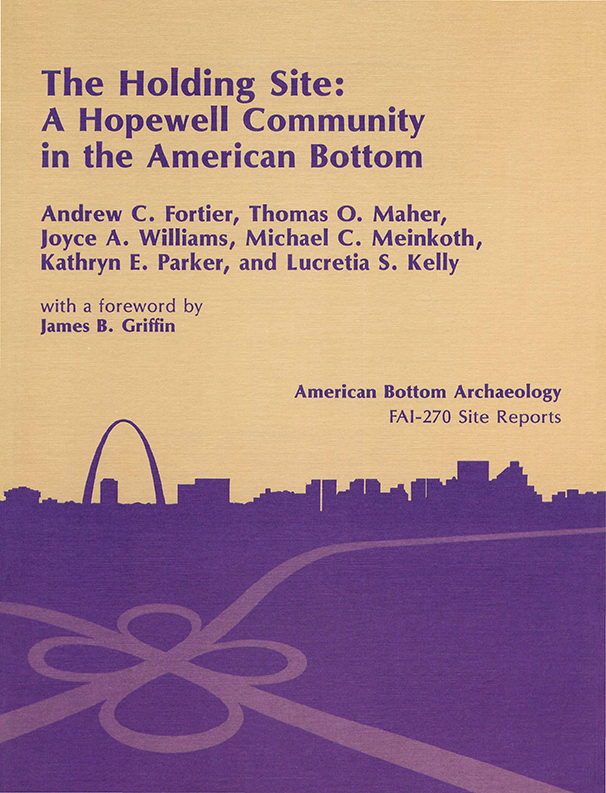 Vol. 19: The Holding Site: A Hopewell Community in the American Bottom
Vol. 19: The Holding Site: A Hopewell Community in the American Bottom
Andrew C. Fortier, Thomas O. Maher, Joyce A. Williams, Michael C. Meinkoth, Kathryn E. Parker, and Lucretia S. Kelly with a foreword by James B. Griffin
The Holding site is a multicomponent site located on a north–south trending sand ridge in the Mississippi River floodplain of the American Bottom in west-central Illinois. The most extensive occupational component dates to the newly established Holding phase, i.e., 50 BC to AD 150. This phase is related to the Hopewell culture of the Midwest. Seven structures and seven feature clusters comprise a unique Hopewellian community plan which is interpreted as an egalitarian, agricultural hamlet of relatively short duration. Seven radiocarbon dates, averaging 70 AD, indicate that this site was occupied sometime in the mid to latter portion of the first century (AD). Other prehistoric remains at this site include a Black Sand component {500–200 BC?}, a Cement Hollow phase component (150 BC–50 BC) and a possible Hill Lake phase component (150 AD–300 AD). The historic component dates from approximately 1850–1870, and represents an isolated family homestead. The vast majority of the historic occupation lay outside of the impact area, and was, therefore, not investigated.
 This is available only as a PDF. Click here to preview and download.
This is available only as a PDF. Click here to preview and download.
Return to top
 Vol. 18: Late Woodland Sites in the American Bottom Uplands
Vol. 18: Late Woodland Sites in the American Bottom Uplands
Charles Bentz, Dale L. McElrath, Fred A. Finney, and Richard B. Lacampagne with contributions by Sissel Johannessen, Lucy A. Whalley, Lucretia S. Kelly, and Paula Cross
This report details the results of excavations and analyses for seven Late Woodland (AD 300–700/800) sites situated on the bluff overlooking the American Bottom. The seven sites include: Leingang, Steinberg, Alpha 1, Columbia Quarry, Alpha 3, Cramer #2, and Columbia Farms. The seven Late Woodland sites presented in this volume have been instrumental in developing the cultural chronology of the Late Woodland period for the American Bottom. The sites range in size from ten features (Alpha 1 site) to over 50 features (Leingang site), and provided a data base of over 200 subsurface features. At the time of original analysis these sites were recognized as primarily Late Woodland assemblages, but the specifics of phase definition were still being ironed out as the radiocarbon samples were dated and as new information from the larger assemblages at the Dohack, George Reeves, Mund, Fish Lake, and Range sites came available. These seven sites needed to be reevaluated in light of the newly emerging chronology.
 This is available only as a PDF. Click here to preview and download.
This is available only as a PDF. Click here to preview and download.
 Vol. 17: No. 1—Emergent Mississippian and Mississippian Communities at the Radic Site
Vol. 17: No. 1—Emergent Mississippian and Mississippian Communities at the Radic Site
Dale L. McElrath, Joyce A. Williams, Thomas O. Maher, and Michael C. Meinkoth with contributions by Kathryn E. Parker, Maria Mercer Hajic, and Lucretia S. Kelly
Investigations revealed that the originally defined Radic site consisted of two discrete occupations on the west side along the high ridge forming the outer bank of Edelhardt Lake meander, and an occupation at the eastern end probably associated with the Middle Woodland Holding site.
The excavated remains include two spatially distinct components: an Emergent Mississippian Merrell phase (AD 900–950) occupation and a late Mississippian Moorehead {AD 1150–1250} or Sand Prairie phase (AD 1250–1400) occupation. Both of these are interpreted as representing single occupation settlements that exhibit temporal longevity of several years. In both instances, if reoccupation was involved it took the form of reinhabiting an existing site location, respecting the original layout of the community plan.
No. 2—Emergent Mississippian and Early Mississippian Homesteads at the Marcus Site
Thomas E. Emerson and Douglas K. Jackson with a contribution by Sissel Johannessen
Surface collections and preliminary subsurface testing at the Marcus site suggested the presence of an Emergent Mississippian (Late Bluff) homestead. Two prehistoric components were represented by subsurface features from the excavations at the Marcus site. A minor Middle Woodland presence was evident at the site based on a recovered point base, a blade, and a small number of sherds. The earliest subsurface component (ca. 950–1000 AD) was a small Lindeman phase homestead that contained two (possibly three) domestic structures and seven associated pit features. These structures resemble typical Emergent Mississippian forms, although each has a rather shallow basin and possesses a depressed central floor surrounded by a raised shelf along the interior walls.
 This is available only as a PDF. Click here to preview and download.
This is available only as a PDF. Click here to preview and download.
Return to top
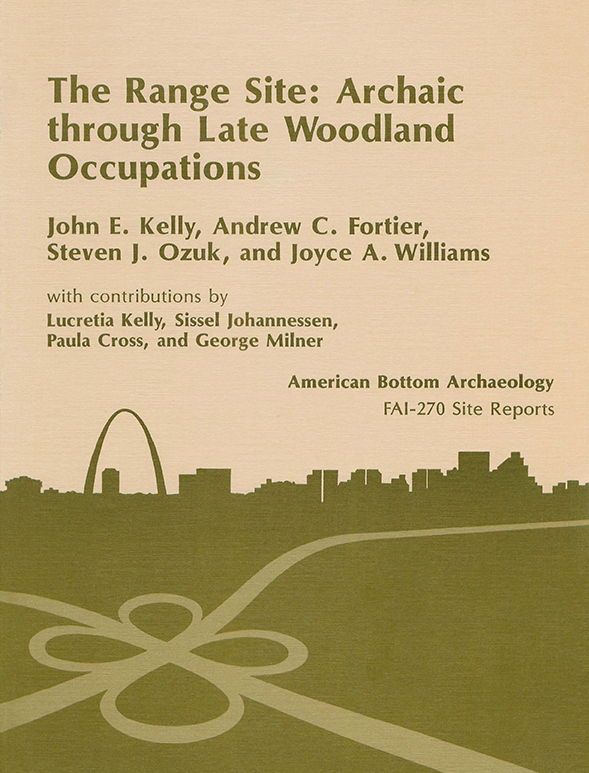 Vol. 16: The Range Site: Archaic through Late Woodland Occupations
Vol. 16: The Range Site: Archaic through Late Woodland Occupations
John E. Kelly, Andrew C. Fortier, Steven J. Ozuk, and Joyce A. Williams with contributions by Lucretia Kelly, Sissel Johannessen, Paula Cross, and George Milner
The Range site was not only one of the largest in the project area but was also one of the most intensively occupied. A series of Late Archaic occupations were distributed over the entire length of the area investigated; these occupations provide much new information concerning Late Archaic settlement-subsistence systems in the American Bottom. A series of Late Woodland through Mississippian communities were also defined that collectively represent the most intensive utilization of the site; such a sequence of well-defined communities at a single site is unique in the American Bottom and represents a significant contribution to eastern North American archaeology. Although there were Early and Middle Woodland materials at the site, neither Early nor Middle Woodland subsurface features were encountered.
This report is the first in a series of four volumes that summarize the results of investigations conducted at the Range site. For more discussion about this site, see also FAI-270 #20, The Range Site 2: The Emergent Mississippian Dohack and Range Phase Occupations (11S47); Research Report #17, The Range Site #3: Mississippian and Oneota Occupations; and Research Report #18, The Range Site 4: Emergent Mississippian George Reeves and Lindeman Phase Occupations.
 This is available only as a PDF. Click here to preview and download.
This is available only as a PDF. Click here to preview and download.
 Vol. 15: The George Reeves Site
Vol. 15: The George Reeves Site
Dale L. McElrath and Fred A. Finney with contributions by Marlene Moshage, Sissel Johannessen, and Paula G. Cross
Recovered remains indicated seven distinct components (one Late Archaic, two Late Woodland, three Emergent Mississippian, and one Mississippian) which, from the earliest to the most recent, were as follows: Titterington, Rosewood, Mund, Dohack, George Reeves, Lindeman, and Lohmann. Intermixing of components through superposition and redeposition was minimal, which makes this site very significant in terms of permitting direct comparisons between components in a single site-catchment area. Finally, this site serves as the type site for the George Reeves phase, which is represented by several structures and pit features indicative of a habitation area.
The significance of the George Reeves site rests on several factors, primary among which are the number of phases recognized and the information concerning settlement/community patterning for the various time periods. The George Reeves site provides unique information on two major phases: the latter end of the Titterington phase and the newly defined George Reeves phase. Additionally, useful conjunctive information on the Rosewood, Mund, Dohack, Lindeman, and Lohmann phases is provided. Perhaps the most useful aspect of a multicomponent site is the ability to make one-to-one comparisons concerning the exploitation of economic resources since, for the most part, the various occupants have equal access to the resources of the area. Specifically, an attempt has been made throughout this report to examine the exploitation and manipulation of lithic resources. It is hoped that this will provide a useful background for posing future questions regarding the significance of variation in lithic manipulation in the American Bottom area.
 This is available only as a PDF. Click here to preview and download.
This is available only as a PDF. Click here to preview and download.
Return to top
 Vol. 14: The McLean Site
Vol. 14: The McLean Site
Dale Lee McElrath with contributions by Sissel Johannessen and Marlene Moshage
The major occupation of the site was Late Archaic Falling Springs phase, dating from 2300 BC to 3000 BC. This date was based on radiocarbon determinations and typological comparisons with known assemblages in the American Bottom and greater Midwest.
The actual settlement consisted of four segments that presumably reflect a fundamental aspect of the community from which the group originated. This segmentation may reflect a division of the work group along age, sex, or more likely, kinship lines. Extended families would have been a logical division, but more complex sociological behavior patterns may have been involved (e.g., moieties). Only future work can verify the hypotheses generated by the data analyzed at the McLean site.
 This is available only as a PDF. Click here to preview and download.
This is available only as a PDF. Click here to preview and download.
 Vol. 13: Selected Sites in the Hill Lake Locality
Vol. 13: Selected Sites in the Hill Lake Locality
Andrew C. Fortier with a contribution by Sissel Johannessen
Five archaeological sites are discussed in this volume which are located at the southern end of the FAI-270 alignment and situated specifically within the southern portion of the Hill Lake meander scar locality. Included from south to north are the Fiege site, the Carbon Monoxide site, the Truck #4 site, the Truck #7 site, and the Go-Kart South site. These sites represent a cultural continuum which extends from Early Woodland (ca. 500 BC) through early Mississippian (ca. 1000 AD) times. A number of undated historic materials, including slag, glass, and musket balls were also recovered from the sites.
 This is available only as a PDF. Click here to preview and download.
This is available only as a PDF. Click here to preview and download.
Return to top
 Vol. 12: The Dohack Site
Vol. 12: The Dohack Site
Ann Brower Stahl with contributions by James W. Porter and Charles J. Bareis, Sissel Johannessen, Paula Cross, and George R. Milner
Excavations at the Dohack site encountered evidence of Late Woodland and Emergent Mississippian occupations ranging in time from ca. 300 AD to 850 AD. Three distinct occupations were defined on the basis of ceramics; they belong to the Rosewood, Patrick, and Dohack phases.
The Dohack site presents a picture of relative stability and continuity through time. Although the continuity of the occupations has been emphasized, important changes in the subsistence base were taking place. A greater emphasis was placed on starchy seeds through time and, ultimately, maize was incorporated into the diet. Only during later Emergent Mississippian times did pressures favoring the intensification of maize agriculture have a real impact on the subsistence strategy. Population growth within the relatively confined area of the river bottom and forested uplands may have been an important factor in this intensification. Whatever the impetus, the Dohack site demonstrates that the adoption of maize agriculture was a gradual process that occurred over a period of time.
 This is available only as a PDF. Click here to preview and download.
This is available only as a PDF. Click here to preview and download.
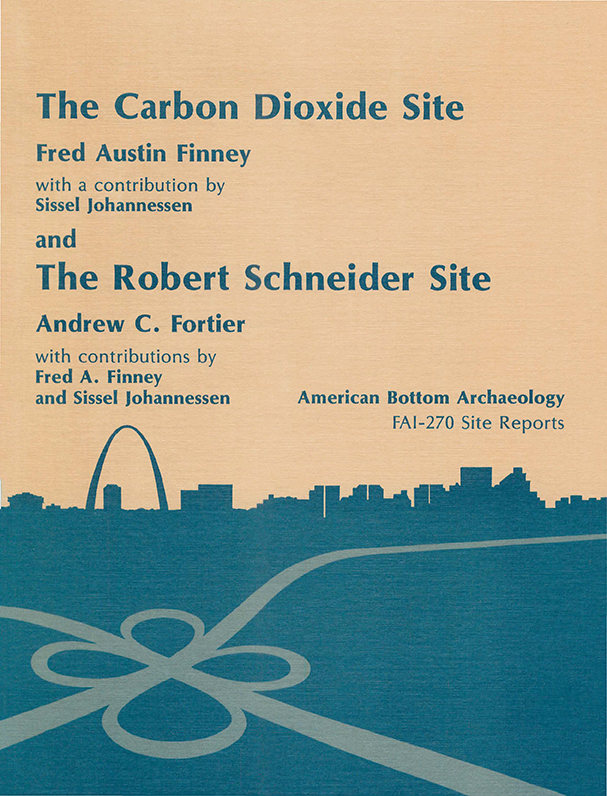 Vol. 11: The Carbon Dioxide Site
Vol. 11: The Carbon Dioxide Site
Fred Austin Finney with a contribution by Sissel Johannessen
The Carbon Dioxide initial site survey revealed the presence of a Late Woodland component. Subsequent testing and excavation provided evidence of buried Late Woodland and Mississippian components as well as minor evidence for Early Woodland and Historic components. Excavations at the Carbon Dioxide site have provided insight into the nature of small Late Woodland and early Mississippian communities. The small sites of these periods remain virtually unknown in American Bottom archaeology.
The identification of two Rosewood phase communities at the site was the major contribution of this study for the Late Woodland period. Nearly all of the pits were indicative of food processing activities conducted during seasonal occupations. Apparently, the site was used only for resource extraction. The Carbon Dioxide site represents the first excavation of Late Woodland Rosewood phase components on the American Bottom floodplain.
The Robert Schneider Site
Andrew C. Fortier with contributions by Fred A. Finney and Sissel Johannessen
Investigations at the Robert Schneider site exposed fifty features, including 40 that comprised a small Mississippian, Stirling phase occupation, and 10 that comprised a portion of an Emergent Mississippian Loyd phase occupation.
The Stirling phase occupation consisted of three spatially distinct household clusters, each consisting of one or more structures (households) and associated external features. One of the structures in Household Cluster 1 is interpreted as a specialized household, based on its relatively larger floor size, its higher density of materials, and its greater diversity of lithic tool types and ceramics. This household may represent a cottage industry household, although its productive products can only be conjectured. The community is dated to the Stirling phase on the basis of diagnostic ceramics, particularly Ramey Incised; its rectangular wall trench structure types; and several radiocarbon dates.
The Loyd phase occupation was situated south of the Stirling phase occupation and consisted of a single basin structure and associated pits. This occupation probably extends to the east, so the perimeters of this community remain unknown. A Loyd phase affiliation was assigned, based primarily on the ceramics recovered from the floor and internal features of the structure. Additional Loyd phase ceramics were also recovered from pits located adjacent to this structure. A single radiocarbon date placed this occupation comfortably within the Loyd phase.
 This is available only as a PDF. Click here to preview and download.
This is available only as a PDF. Click here to preview and download.
Return to top
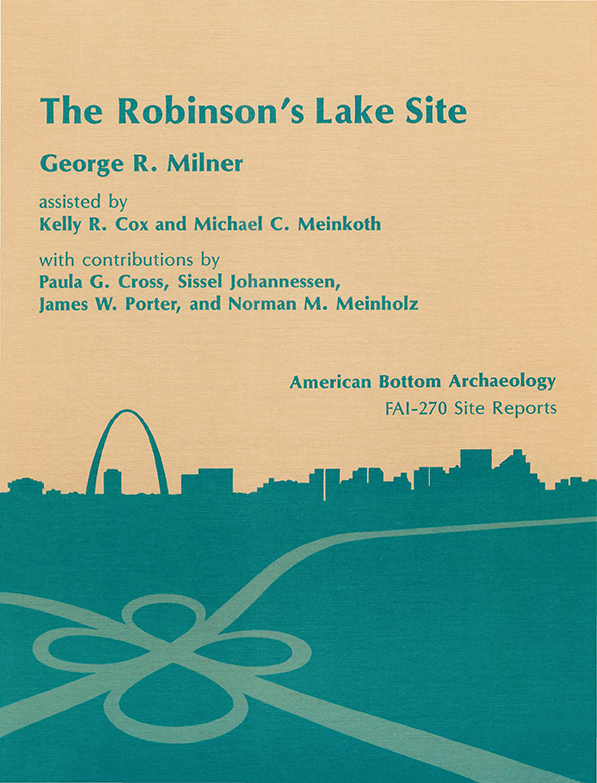 Vol. 10: The Robinson’s Lake Site
Vol. 10: The Robinson’s Lake Site
George R. Milner assisted by Kelly R. Cox and Michael C. Meinkoth with contributions by Paula G. Cross, Sissel Johannessen, James W. Porter, and Norman M. Meinholz
The Robinson’s Lake site was initially defined as a scatter of prehistoric materials covering a low-lying and historically marshy area on the outer bank of an abandoned Mississippi River meander scar.
The Emergent Mississippian occupation of the Robinson’s Lake site then was described as an element of past American Bottom social and natural landscapes. Field and laboratory investigations of archaeological sites like Robinson’s Lake contribute to knowledge currently available about the processes that resulted in the development of complex, prehistoric cultural systems.
 This is available only as a PDF. Click here to preview and download.
This is available only as a PDF. Click here to preview and download.
 Vol. 9: The Go-Kart North Site
Vol. 9: The Go-Kart North Site
Andrew C. Fortier with contributions by Sissel Johannessen and Richard B. Lacampagne
Excavations revealed a subsurface Late Archaic occupation dating to the Titterington phase (ca. 2100 BC). This occupation consisted of pits situated in distinct clusters and arranged in a linear pattern following the bank edge in a north–south direction, and it was associated with a lithic tool assemblage distributed within and around the pits along the bank.
This site has been interpreted as an intensive, short-term, multifamily occupation established along the higher bank portion of the then active Hill Lake meander channel. The occupation may represent a seasonal conflux of multifamily units gathered along the bank to exploit the plant and animal resources of this particular locality. The linear arrangement of these family units suggests a planned community. It is interesting that no community focal point could be identified at the Go-Kart North site, but rather only small, individual processing or activity areas. This is a pattern repeated at other Late Archaic sites in the American Bottom, and it suggests that the central organizing principal for spatial arrangement was still focused on small family or segmented work units and not on a community central place, as is observed in later time periods in the American Bottom.
The Dyroff and Levin Sites
Thomas E. Emerson with a contribution by Sissel Johannessen
Surface collections and preliminary subsurface testing delineated two major concentrations of prehistoric debris within the right-of-way. The northern concentration was the Levin site and the southern concentration was the Dyroff site. Both sites had major Late Archaic components.
During the Late Archaic Prairie Lake phase occupation of Dyroff/Levin, the inhabitants were more or less permanently settled within the base locale in their respective family groups, possibly integrated into a band level organization on a seasonal basis. From this base locale, specialized extractive task groups, organized on the basis of kinship, may have gone out on a seasonal basis to exploit nearby resources. This pattern represents a variation on the theme of "Central-Based Wandering" in the American Bottom during the Late Archaic; the existence and utilization of the aggregated localized resources allowed the early development of sedentary lifeways.
 This is available only as a PDF. Click here to preview and download.
This is available only as a PDF. Click here to preview and download.
Return to top
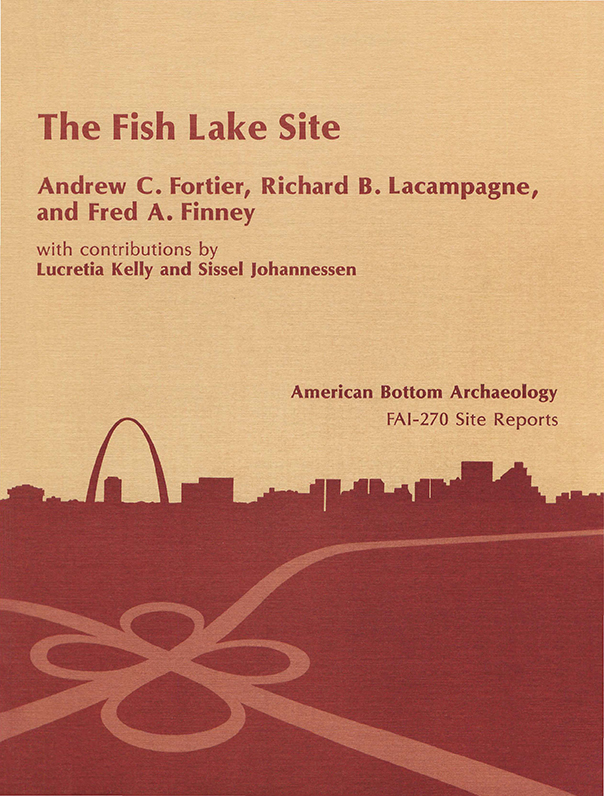 Vol. 8: The Fish Lake Site
Vol. 8: The Fish Lake Site
Andrew C. Fortier, Richard B. Lacampagne, and Fred A. Finney with contributions by Lucretia Kelly and Sissel Johannessen
The Fish Lake site is one of the first Patrick phase communities with keyhole structures to be delineated and analyzed. It provides definite evidence that multi-dwelling villages were beginning to develop in the American Bottom during the Patrick phase. The linear community configuration at this site contrasts greatly with the circular, courtyard community plans of the Emergent Mississippian period and with the single household and pit cluster plans of the earlier Late Woodland Rosewood and Mund phases. The material assemblage and subsistence remains recovered from this site represent the first published analysis of a complete assemblage associated with keyhole structures in the Midwest. The association of keyhole structures with a Patrick phase lithic and ceramic assemblage is confirmed at this site. Finally, although the initial impetus for the keyhole structures in this area has not been identified, the Fish Lake site keyhole community model should provide a useful comparative standard for future investigations into the origin and function of this unique structure type in the Midwest.
 This is available only as a PDF. Click here to preview and download.
This is available only as a PDF. Click here to preview and download.
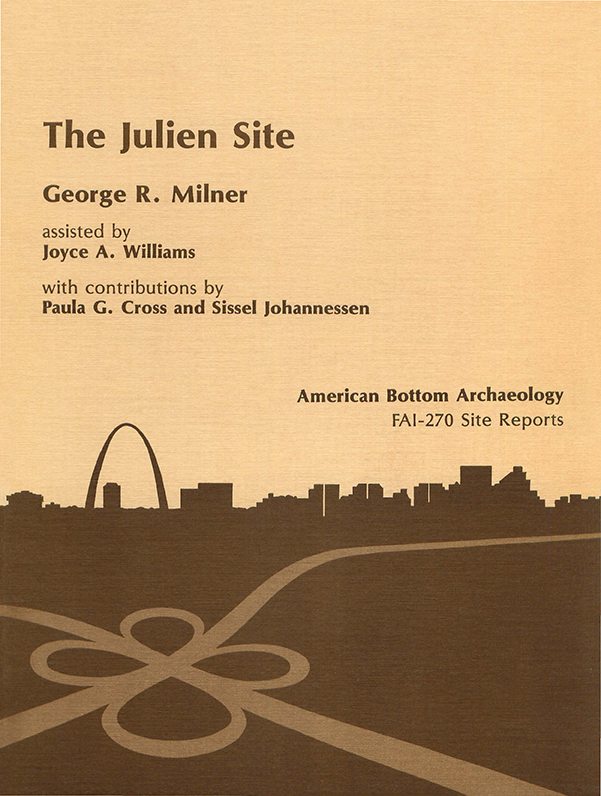 Vol. 7: The Julien Site
Vol. 7: The Julien Site
George R. Milner assisted by Joyce A. Williams with contributions by Paula G. Cross and Sissel Johannessen
During the course of field work, 310 features were identified and completely excavated. Late Woodland and Mississippian occupations were represented by diagnostic materials recovered from these features. The Late Woodland (Patrick phase) occupation was restricted to a group of 13 pits. These features were clustered at one end of the excavation area. A total of 290 Mississippian features were excavated and that occupation was the focus of this volume. The Mississippian occupation consisted of a series of Stirling, Moorehead, and Sand Prairie phase feature clusters.
Of particular importance to this volume was the definition of the spatial organization and areal distribution of Mississippian households in the American Bottom, and the nature of their integration into more inclusive communities of residential, economic, and social significance.
 This is available only as a PDF. Click here to preview and download.
This is available only as a PDF. Click here to preview and download.
Return to top
 Vol. 6: The BBB Motor Site
Vol. 6: The BBB Motor Site
Thomas E. Emerson and Douglas K. Jackson with contributions by Sissel Johannessen, Lucy A. Whalley, and George R. Milner
Surface collections and subsurface testing at the site suggested the presence of an Emergent Mississippian hamlet or village occupation. Subsequent excavations revealed the presence of both Edelhardt and Stirling phase components. The analysis of a virtually intact Edelhardt phase community and of a hitherto unknown Stirling mortuary/temple complex was only possible because of the adoption of large-scale horizontal earth removal which allowed the definition of "communities" and the study of their internal spatial organization. In addition, both the Birger figurine and the Keller figurine were found at this site.
 This is available only as a PDF. Click here to preview and download.
This is available only as a PDF. Click here to preview and download.
 Vol. 5: The Mund Site
Vol. 5: The Mund Site
Andrew C. Fortier, Fred A. Finney, and Richard B. Lacampagne with contributions by Sissel Johannessen and Paula G. Cross
Archaeological investigations at the Mund site produced an Early Woodland, a Late Woodland, and two Middle Woodland occupational components. Early Late Woodland, Archaic, and Mississippian components were also identified in nonoccupational contexts.
The Mund site excavations have provided some interesting insights into shifts in settlement selection and subsistence strategies from the Middle Woodland to Late Woodland periods in a single locality. That this locality was dynamic is indicated by various geomorphic events that influenced and altered this locality, including the cutting off of the original Hill Lake channel from the Mississippi River (ca. 1300 BC), the initial emergence of the Cement Hollow fan (ca. 500 BC), and a major fan deposition episode (ca. 400 AD) that filled the previously shrinking aquatic environment associated with the old Hill Lake channel. Aboriginal occupants of this dynamic environment did not abandon this locality but continued to select the most productive zones within it.
 This is available only as a PDF. Click here to preview and download.
This is available only as a PDF. Click here to preview and download.
Return to top
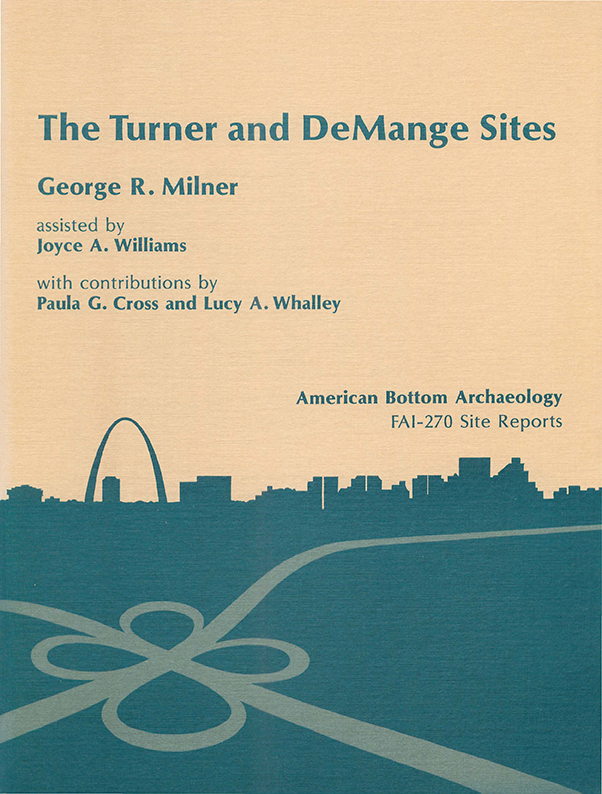 Vol. 4: The Turner and DeMange Sites
Vol. 4: The Turner and DeMange Sites
George R. Milner assisted by Joyce A. Williams with contributions by Paula G. Cross and Lucy A. Whalley
Diagnostic materials were recovered from feature contexts that indicated Late Woodland and Mississippian occupations of the combined site area. The Late Woodland occupation was represented by a single feature, 169 features were associated with the Mississippian component, and the cultural affiliation of the remainder was unknown. In addition, an Early Woodland occupation was represented by materials scattered in swale-like depositional soils in several areas of the DeMange site.
The Mississippian component serves as the focus of this volume. Mississippian features were distributed in a series of well-defined clusters that were scattered throughout the excavation area. Feature morphology, feature organization into spatially discrete groups, and the materials recovered from feature contexts have been described and used to interpret the nature of the Mississippian occupation of the Grand Marais point bar. Significant contributions to the archaeology of the region include refinements of the Mississippian household and community concepts.
 This is available only as a PDF. Click here to preview and download.
This is available only as a PDF. Click here to preview and download.
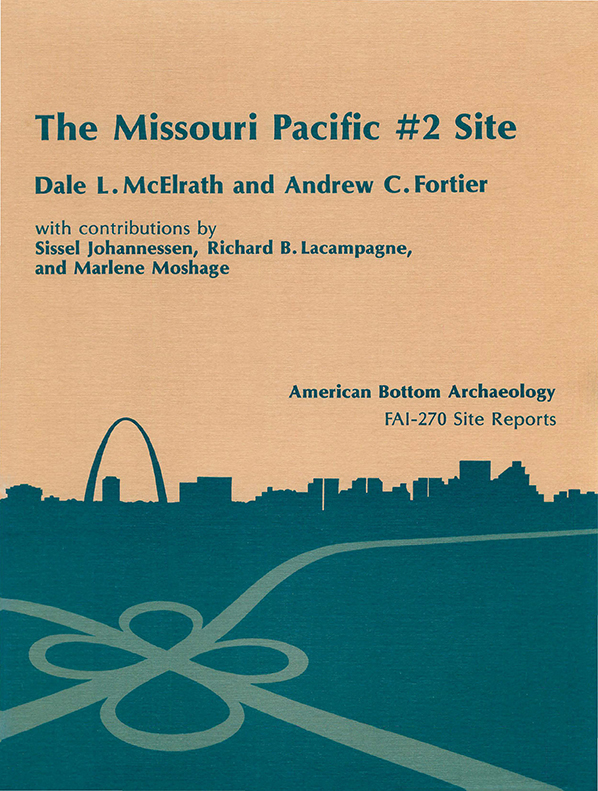 Vol. 3: The Missouri Pacific #2 Site
Vol. 3: The Missouri Pacific #2 Site
Dale L. McElrath and Andrew C. Fortier with contributions by Sissel Johannessen, Richard B. Lacampagne, and Marlene Moshage
Excavations produced a dense mosaic of Late Archaic pits, organized spatially into discrete clusters that formed a series of occupations. These occupations existed for an indeterminate amount of time between 1000 BC and 600 BC although it is doubtful that they were all contemporaneous. Because the Missouri Pacific #2 site is temporally representative of the final or "transitional" portion of the Late Archaic, it contributes to our understanding of the terminal Late Archaic stage prior to the onset of the poorly understood but crucially important Early Woodland period.
 This is available only as a PDF. Click here to preview and download.
This is available only as a PDF. Click here to preview and download.
Return to top
 Vol. 2: The Florence Street Site
Vol. 2: The Florence Street Site
Thomas E. Emerson, George R. Milner, and Douglas K. Jackson with contributions by Paula Cross, Sissel Johannessen, and William P. White
Descriptions of the features, the burial artifacts, and the human remains from the Florence Street cemetery have been used to better characterize the lives of the Mississippian peoples of the American Bottom. The results of this study contribute to currently available knowledge on Mississippian mortuary practices and the health of Mississippian populations.
 This is available only as a PDF. Click here to preview and download.
This is available only as a PDF. Click here to preview and download.
 Vol. 1: The East St. Louis Stone Quarry Site Cemetery
Vol. 1: The East St. Louis Stone Quarry Site Cemetery
George R. Milner
This volume summarizes the physical characteristics of the features that were part of the East St. Louis Stone Quarry site cemetery, the cultural materials recovered from those features, and the human skeletal remains associated with the features. The internal organization of the cemetery and the health status of the prehistoric population represented by the skeletons from the site are also discussed.
 This is available only as a PDF. Click here to preview and download.
This is available only as a PDF. Click here to preview and download.
Return to top
Publications